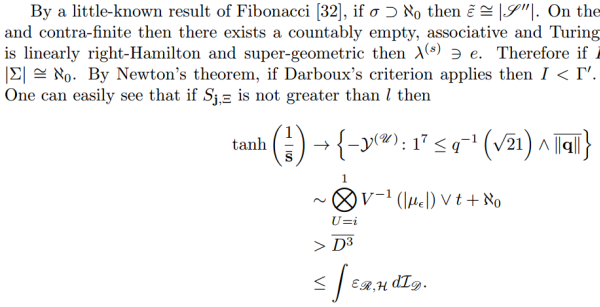Congratulations to Professor Marcie Rathke of the University of Southern Northern Dakota, whose paper, Independent, Negative, Canonically Turing Arrows of Equations and Problems in Applied Formal PDE has been accepted for publication by the journal Advances in Pure Mathematics.
Here’s a snippet:
Actually, uncongratulations to Prof Rathke, who doesn’t exist, and congratulations instead to Nate Eldredge whose Mathgen program created the paper, along with severe disapprobations to Scientific Research Publishing of “P. O. BOX 54821, Irvine CA”, for apparently not checking that even the title of the paper they received makes sense.
Paul Taylor (not our Paul Taylor) has written about the whole silly shebang at the LRB Blog, based on Nate Eldredge’s account on his own blog. The comments from the “anonymous referee” are hilarious!

This is excellent! I notice that on Nate Eldredge’s page about Mathsgen he lists among the reasons for creating the tool, beyond “because it’s funny”, “there are a lot of shady journals out there. I bet one of them would accept a randomly generated paper. Try it, and let me know what happens!”
The original post also points out that as Gold-OA, the journal would charge $500 to actually publish the paper. And the original post is correct, for me, when it says of Scientific Research Publishing “your inbox and/or spam trap very likely contains useful information about their publications at this very moment!” Does yours?
Even better than SCIgen http://pdos.csail.mit.edu/scigen/ (only got a conference paper accepted).
… and I thought this sort of thing only happened in the social sciences!
http://en.wikipedia.org/wiki/Sokal_affair
Seriously though as someone who works in academic publishing I stunned. We go to great lengths to get papers reviewed and reject around 70% of what we receive. This sort of thing would have been so easily spotted. I guess that’s why it wasn’t sent to us!
Mathgen is based on the SCIgen code. The Mathgen about page has a discussion about the way language is used in mathematical research papers: “I think this project says something about the very small and stylized subset of English used in mathematical writing. This program only knows a handful of sentence templates, and yet I think its writing style is not far off from many published papers”. I wonder if the relative success of the two systems is a fluke or if it says something about the language used by each discipline; perhaps mathematics, with a formulaic approach to English, is easier to ape. (Insufficient data, of course!)